1. Mensah GA, Wei GS, Sorlie PD, et al. Decline in cardiovascular mortality: possible causes and implications. Circ Res. 2017; 120:366–380. PMID:
28104770.


2. Rehan F, Qadeer A, Bashir I, Jamshaid M. Risk factors of cardiovascular disease in developing countries. Int Curr Pharm J. 2016; 5:69–72.
3. Gaziano TA, Bitton A, Anand S, Abrahams-Gessel S, Murphy A. Growing epidemic of coronary heart disease in low- and middle-income countries. Curr Probl Cardiol. 2010; 35:72–115. PMID:
20109979.


4. Statistics Korea. Cause of death statistics in 2018. Daejeon: Statistics Korea;2018.
5. Lee SW, Kim HC, Lee HS, Suh I. Thirty-year trends in mortality from cardiovascular diseases in Korea. Korean Circ J. 2015; 45:202–209. PMID:
26023308.


6. Lee SW, Kim HC, Lee HS, Suh I. Thirty-year trends in mortality from cerebrovascular diseases in Korea. Korean Circ J. 2016; 46:507–514. PMID:
27482259.


7. Sung KC, Ryu S, Cheong ES, et al. All-cause and cardiovascular mortality among Koreans: effects of obesity and metabolic health. Am J Prev Med. 2015; 49:62–71. PMID:
26094228.

8. Sung KC, Ryu S, Wild SH, Byrne CD. An increased high-density lipoprotein cholesterol/apolipoprotein A-I ratio is associated with increased cardiovascular and all-cause mortality. Heart. 2015; 101:553–558. PMID:
25637367.
9. Yi SW, Yoo SH, Sull JW, Ohrr H. Association between alcohol drinking and cardiovascular disease mortality and all-cause mortality: Kangwha cohort study. J Prev Med Public Health. 2004; 37:120–126. PMID:
25178442.

10. Kim EH, Lee H, Shin DW, et al. Association between weight changes after smoking cessation and cardiovascular disease among the Korean population. Korean J Fam Med. 2017; 38:122–129. PMID:
28572887.


11. Bae JC, Cho NH, Suh S, et al. Cardiovascular disease incidence, mortality and case fatality related to diabetes and metabolic syndrome: a community-based prospective study (Ansung-Ansan cohort 2001-12). J Diabetes. 2015; 7:791–799. PMID:
25407754.

12. Song YM, Ferrer RL, Cho SI, Sung J, Ebrahim S, Davey Smith G. Socioeconomic status and cardiovascular disease among men: the Korean national health service prospective cohort study. Am J Public Health. 2006; 96:152–159. PMID:
16373668.


13. Park K, Lim S, Park Y, Ju W, Shin Y, Yeom H. Cardiovascular disease risk factors and obesity levels in Korean adults: results from the Korea National Health and Nutrition Examination Survey, 2007–2015. Osong Public Health Res Perspect. 2018; 9:150–159. PMID:
30159220.


14. Korean Society of Lipid and Atherosclerosis. Dyslipidemia fact sheets in Korea. Seoul: Korean Society of Lipid and Atherosclerosis;2020.
15. Lee H, Park S, Kim HC. Temporal and geospatial trends of hypertension management in Korea: a nationwide study 2002–2016. Korean Circ J. 2019; 49:514–527. PMID:
30808085.


16. Ko SH, Han K, Lee YH, et al. Past and current status of adult type 2 diabetes mellitus management in Korea: a national health insurance service database analysis. Diabetes Metab J. 2018; 42:93–100. PMID:
29676539.
17. Korean Society Hypertension (KSH). Hypertension Epidemiology Research Working Group. Kim HC, Cho MC. Korea hypertension fact sheet 2018. Clin Hypertens. 2018; 24:13. PMID:
30288297.


18. Rhee EJ. Prevalence and current management of cardiovascular risk factors in Korean adults based on fact sheets. Endocrinol Metab (Seoul). 2020; 35:85–94. PMID:
32207267.


19. Shin HJ, Park YH, Cho BK. Recent surgical outcomes of congenital heart disease according to Korea Heart Foundation data. Korean Circ J. 2020; 50:677–690. PMID:
32212426.


20. Won TY, Kang BS, Im TH, Choi HJ. The study of accuracy of death statistics. J Korean Soc Emerg Med. 2007; 18:256–262.
21. Kim HJ, Kim Y, Cho Y, Jun B, Oh KW. Trends in the prevalence of major cardiovascular disease risk factors among Korean adults: results from the Korea National Health and Nutrition Examination Survey, 1998–2012. Int J Cardiol. 2014; 174:64–72. PMID:
24742812.

22. Kim HC, Oh SM. Noncommunicable diseases: current status of major modifiable risk factors in Korea. J Prev Med Public Health. 2013; 46:165–172. PMID:
23946874.


23. Lee JH, Lim NK, Cho MC, Park HY. Epidemiology of heart failure in Korea: present and future. Korean Circ J. 2016; 46:658–664. PMID:
27721857.


24. Murakoshi N, Aonuma K. Epidemiology of arrhythmias and sudden cardiac death in Asia. Circ J. 2013; 77:2419–2431. PMID:
24067274.

25. Lee SR, Choi EK. Prevalence of atrial fibrillation in Korean population. Int J Arrhythm. 2017; 18:195–204.
26. Wilmot KA, O'Flaherty M, Capewell S, Ford ES, Vaccarino V. Coronary heart disease mortality declines in the United States from 1979 through 2011: evidence for stagnation in young adults, especially women. Circulation. 2015; 132:997–1002. PMID:
26302759.


27. Zhang Y, Vittinghoff E, Pletcher MJ, et al. Associations of blood pressure and cholesterol levels during young adulthood with later cardiovascular events. J Am Coll Cardiol. 2019; 74:330–341. PMID:
31319915.


28. Lee H, Cho SM, Park JH, Park S, Kim HC. 2017 ACC/AHA blood pressure classification and cardiovascular disease in 15 million adults of age 20–94 years. J Clin Med. 2019; 8:1832.

29. Yang S, Khang YH, Chun H, Harper S, Lynch J. The changing gender differences in life expectancy in Korea 1970–2005. Soc Sci Med. 2012; 75:1280–1287. PMID:
22739261.

30. Roth GA, Johnson C, Abajobir A, et al. Global, regional, and national burden of cardiovascular diseases for 10 causes, 1990 to 2015. J Am Coll Cardiol. 2017; 70:1–25. PMID:
28527533.


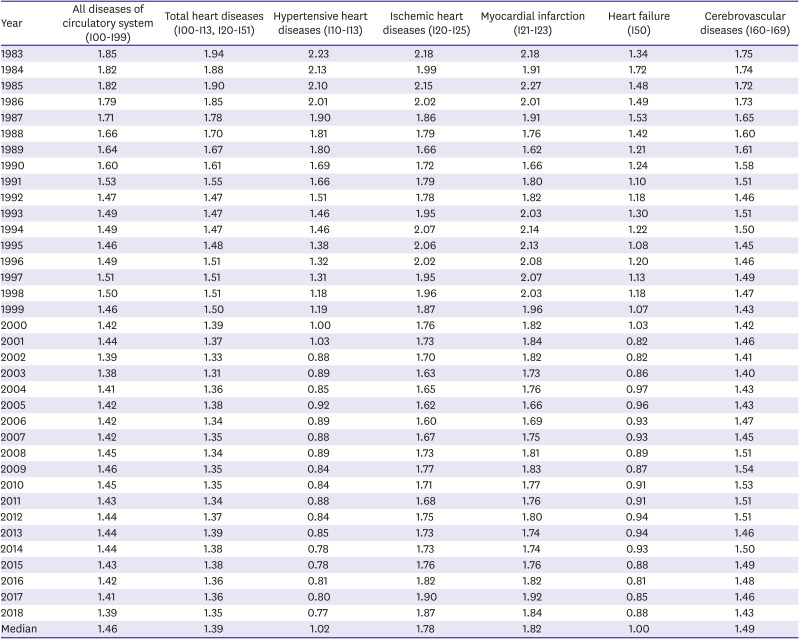




 PDF
PDF Citation
Citation Print
Print



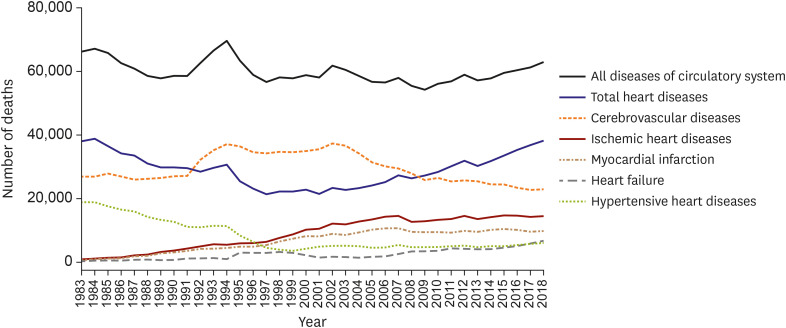
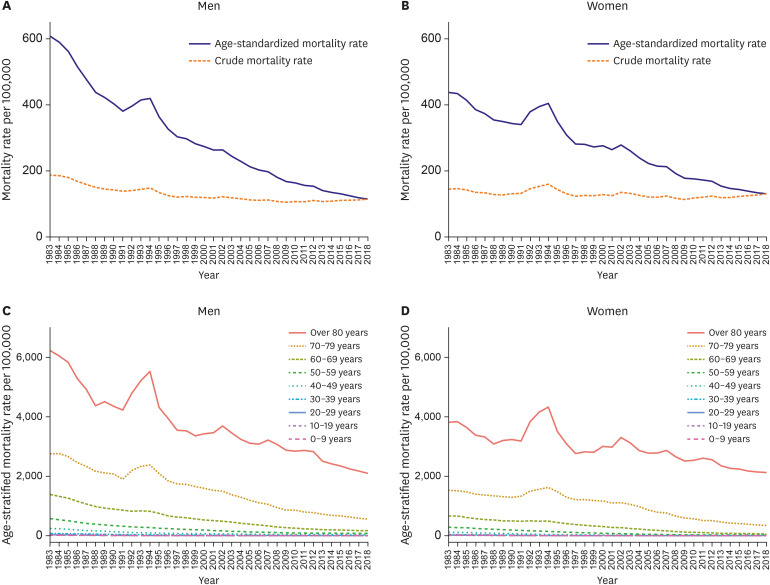
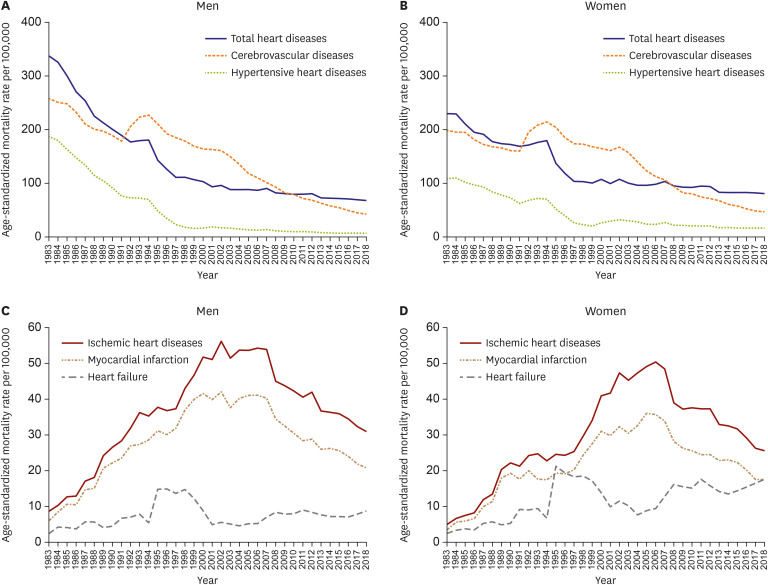
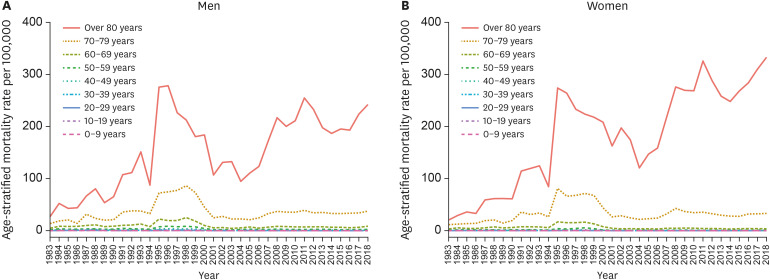
 XML Download
XML Download